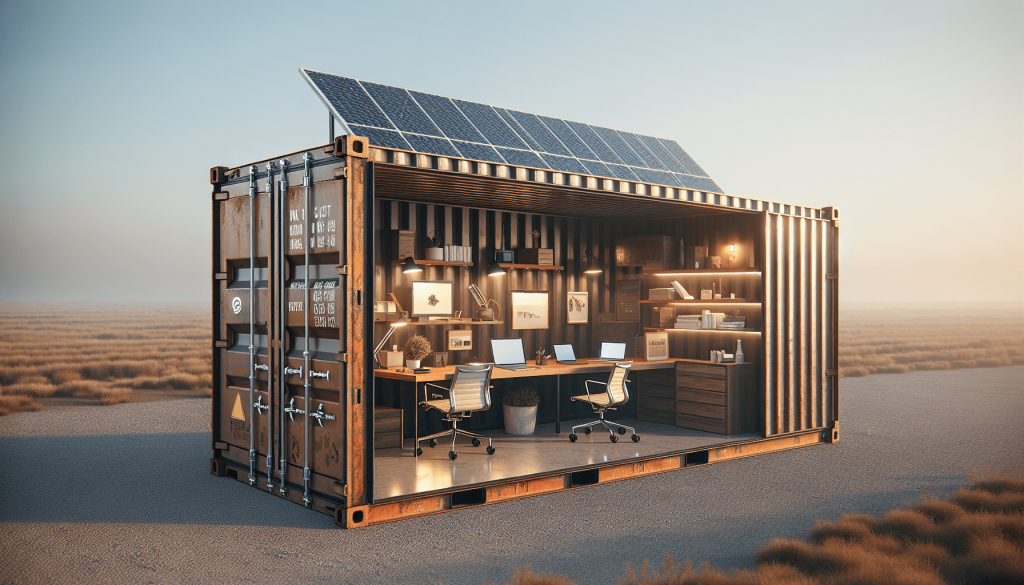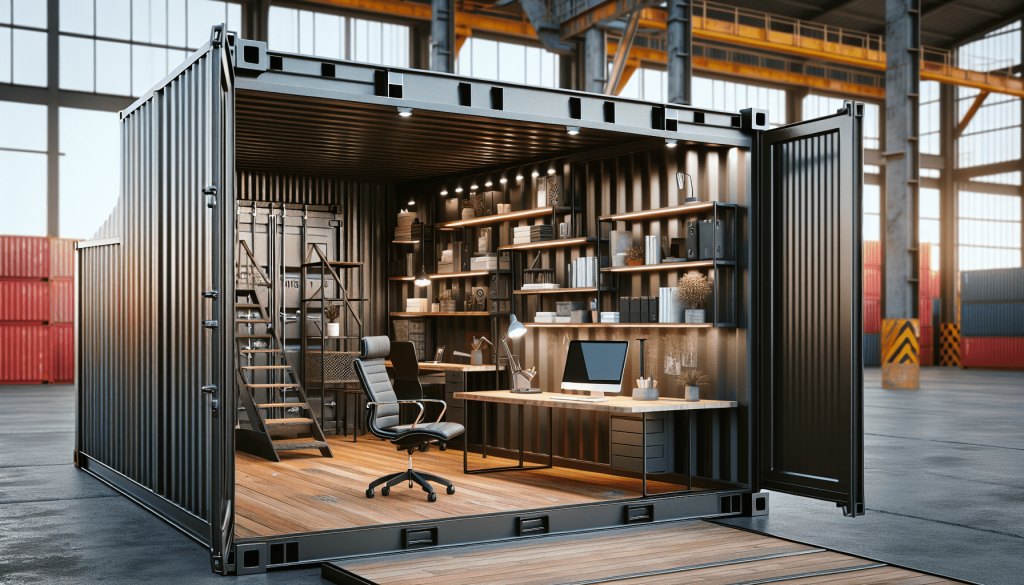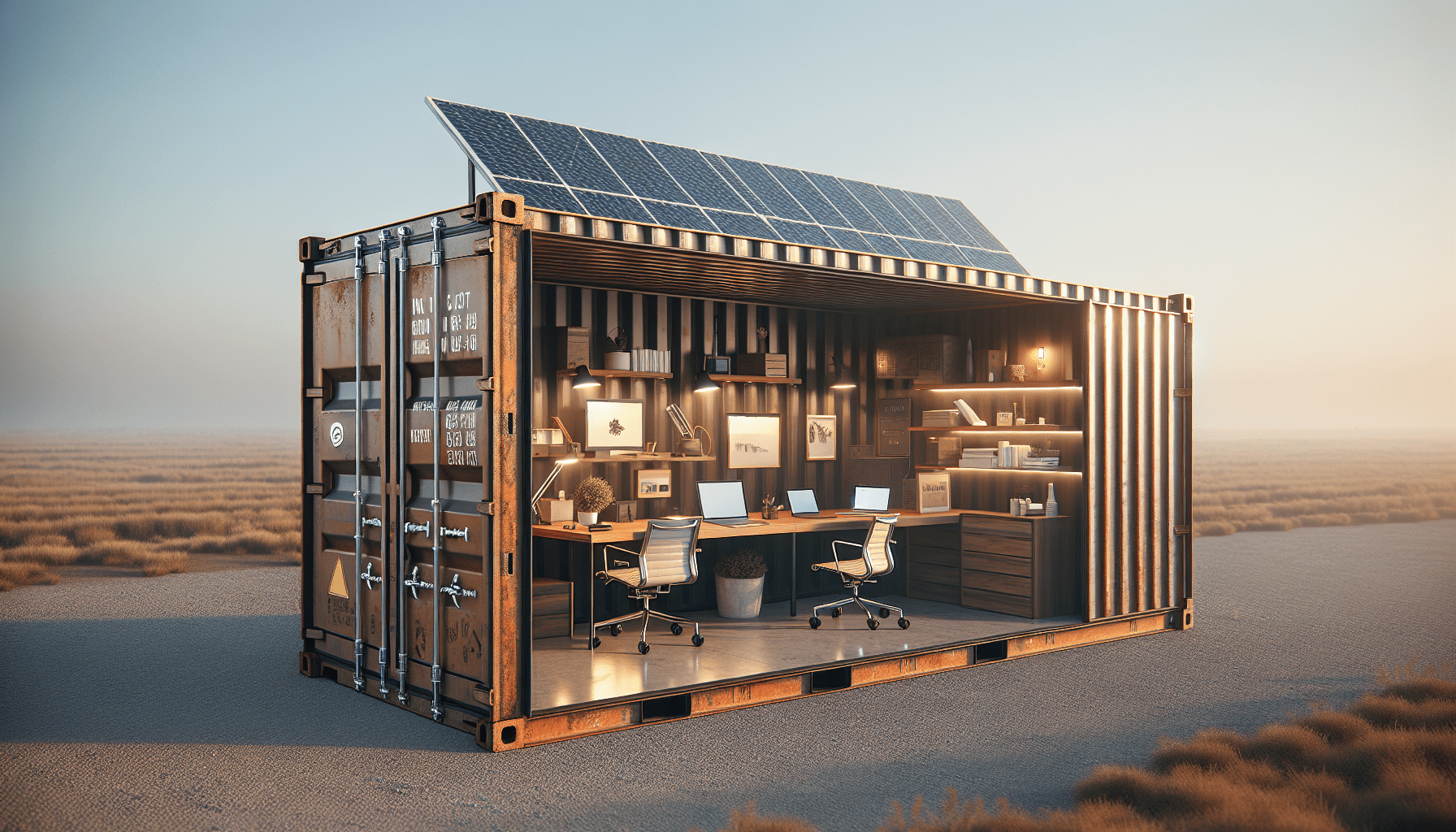Imagine having your very own office space that is compact, sustainable, and easily transportable. Well, the answer to whether you can turn a shipping container into an office is a resounding yes! In recent years, repurposing shipping containers has become a popular trend, offering a cost-effective and environmentally-friendly solution for creating functional workspaces. With a bit of creativity and ingenuity, these rugged containers can be transformed into comfortable and versatile offices, providing a unique and stylish solution for remote work or small business needs. So, if you’re looking for a flexible and innovative workspace, why not consider turning a shipping container into your dream office?
Designing a Shipping Container Office
If you’re looking for a unique and cost-effective solution for your office space, turning a shipping container into an office may be the perfect option for you. Not only do shipping container offices offer versatility and mobility, but they also provide a trendy and modern aesthetic. In this comprehensive guide, we will walk you through every step of designing your very own shipping container office.
Choosing the Right Shipping Container
The first step in designing a shipping container office is selecting the right container. There are several factors to consider when choosing a container, such as size, condition, and functionality. Standard shipping containers typically come in two sizes: 20 feet and 40 feet. You must assess your space and determine which size best suits your needs.
When it comes to condition, it’s essential to inspect the container carefully. Look for any signs of damage, such as rust or holes, as these may affect the structural integrity of the office. Additionally, consider the functionality of the container. Does it need any specific features, such as extra doors or windows? By carefully considering these factors, you can ensure that you choose the best shipping container for your office.
Structural Modifications
Once you have selected a suitable shipping container, it’s time to make structural modifications to transform it into an office space that meets your requirements. Structural modifications may include cutting openings for windows and doors, reinforcing the container’s structure, and adding additional support beams if necessary.
Working with a professional and experienced contractor is crucial during this phase. They will ensure that the modifications are done correctly, maintaining the container’s structural integrity while creating the desired layout for your office.
Interior Layout and Design
With the structural modifications complete, it’s time to focus on the interior layout and design of your shipping container office. The space inside the container may initially seem limited, but with careful planning and creativity, you can optimize every square inch.
Consider your office’s functional requirements and determine the best layout that maximizes productivity and efficiency. This may involve incorporating workstations, meeting areas, storage solutions, and even a breakroom or kitchenette. Collaborate with an interior designer to create a space that not only meets your practical needs but also reflects your brand’s values and aesthetic.
Permits and Legal Considerations
Before embarking on the construction of your shipping container office, it’s vital to ensure that you have the necessary permits and comply with all legal considerations. Failure to do so may result in fines or even the dismantling of your office.
Zoning and Building Codes
Firstly, research your local zoning regulations to determine if shipping container offices are allowed in your area. Some cities may have restrictions on their use, while others embrace them as innovative solutions for office spaces. Additionally, familiarize yourself with building codes that outline specific requirements for the construction and safety of your office.
Permit Applications
After understanding the zoning and building code requirements, it’s time to apply for the necessary permits. Contact your local building department or planning office to obtain the appropriate application forms and additional information on the process. Ensure that you provide all required documents and follow any guidelines or guidelines outlined by the authorities.
Environmental and Safety Regulations
Apart from zoning and building codes, it’s essential to consider environmental and safety regulations. These may include compliance with energy efficiency standards, proper waste management, and fire safety measures. Consult with professionals in these fields to ensure that your shipping container office meets all necessary environmental and safety requirements.

Electrical and Plumbing Systems
For a functional and comfortable office space, you need to plan and install proper electrical and plumbing systems within your shipping container.
Designing the Electrical System
Hiring a licensed electrician is crucial when designing the electrical system for your shipping container office. They will assess your power requirements, ensure proper wiring and grounding, and install fixture and outlet placements suitable for your office’s layout. Consider energy-efficient lighting options and any additional electrical needs, such as computer systems or specialty equipment.
Installing Plumbing Connections
Depending on the intended use of your office, you may need to install plumbing connections for water supply and drainage. Consult with a licensed plumber to design and install these systems efficiently and in compliance with local building codes. Plumbing considerations may include installing sinks, toilets, or even a small kitchenette area if required.
Insulation and Climate Control
To create a comfortable working environment in your shipping container office, insulation and climate control are crucial aspects to consider.
Insulation Options
Shipping containers are made of metal, which can make them susceptible to temperature fluctuations. Proper insulation is necessary to regulate the internal temperature and prevent excessive heat or cold. There are various insulation options available, including spray foam insulation, rigid foam insulation, or even eco-friendly alternatives like recycled denim insulation. Consult with insulation professionals to determine the best option for your climate and budget.
Heating and Cooling Solutions
In addition to insulation, you need to consider heating and cooling solutions to maintain a comfortable temperature. Options may include HVAC systems, portable heaters or air conditioners, or even energy-efficient alternatives like geothermal or solar-powered systems. Assess your office’s size, climate conditions, and budget to choose the best heating and cooling solution that meets your needs.

Furnishing and Decor
Once the structural and functional aspects of your shipping container office are complete, it’s time to focus on furnishing and decorating the space.
Space Optimization
Since shipping containers have limited square footage, space optimization is essential. Consider multi-purpose furniture, compact storage solutions, and ergonomic office layouts to make the most of your available space. Collaborate with an interior designer who specializes in small spaces to ensure that your office remains functional and comfortable.
Ergonomic Furniture
Creating a comfortable and ergonomic workspace is vital for the well-being and productivity of your employees. Choose ergonomic furniture, such as adjustable desks and chairs, that promote proper posture and reduce the risk of musculoskeletal disorders. Prioritize employee health and comfort to create a productive work environment.
Aesthetics and Branding
Your shipping container office is not only a functional workspace but also a representation of your brand. Consider incorporating your brand colors, logos, and artwork into the office design to create a cohesive and visually appealing space. This will not only impress clients and visitors but also create a sense of identity and pride among your employees.
Security and Safety Measures
Ensuring the security and safety of your shipping container office is paramount. Implementing appropriate measures will protect your assets, employees, and business operations.
Entrance Security
Secure the entrance of your shipping container office by installing sturdy doors with proper locks and security mechanisms. Consider access control systems, such as keyless entry systems or swipe cards, to restrict entry to authorized personnel only. Installing security cameras and alarm systems can also provide an additional layer of protection.
Fire Safety
Fire safety is a crucial consideration in any office space. Install fire alarms, smoke detectors, and fire extinguishers to mitigate the risk of fire and ensure you comply with building codes. Regularly inspect and maintain these fire safety devices to guarantee their optimal functioning.
Emergency Exits
It’s essential to have clearly marked and accessible emergency exits in your shipping container office. Consider incorporating exit signs, emergency lighting, and fire escape routes to ensure the safety of your employees in case of an emergency. Educate your employees on the location of emergency exits and conduct regular drills to reinforce safety protocols.
Accessories and Amenities
To create a functional and comfortable workspace, consider incorporating additional accessories and amenities into your shipping container office.
Windows and Doors
Incorporating windows and additional doors into your shipping container office can enhance natural light, ventilation, and aesthetic appeal. Windows can make the space feel more open and welcoming, while additional doors can improve accessibility and traffic flow within the office.
Lighting
Proper lighting is vital for maintaining a productive and pleasant work environment. Consider a combination of natural light, overhead lighting, and task lighting to ensure sufficient illumination throughout the office. Opt for energy-efficient lighting options to reduce electricity costs and environmental impact.
Soundproofing
Shipping containers can be prone to noise transmission, especially if located in a bustling environment. Soundproofing measures, such as installing acoustic panels or insulation, can help minimize noise distractions and create a quieter and more focused workspace.
Budgeting and Cost Considerations
Before embarking on the journey of designing a shipping container office, it’s essential to consider the budget and associated costs.
Container Purchase or Rent
One of the primary costs to consider is whether to purchase a shipping container or rent one. Purchasing a container provides long-term ownership but involves higher upfront costs, while renting allows for flexibility but may lead to higher recurring expenses. Thoroughly assess your budget and long-term plans to decide which option suits your needs.
Modifications and Construction Costs
The cost of structural modifications, interior design, electrical and plumbing systems, insulation, and HVAC installations should all be factored into your budget. Consult with contractors and designers to obtain accurate cost estimates for each aspect of the project.
Operating and Maintenance Expenses
Beyond the initial construction costs, it’s essential to consider ongoing expenses such as utilities, maintenance, and insurance. Ensure that you have budgeted for these expenses to sustain your shipping container office in the long run.
Sustainability and Green Initiatives
Designing a shipping container office offers an opportunity to embrace sustainability and eco-friendly practices.
Solar Power Systems
Consider installing solar panels on the roof of your container office to harness renewable solar energy. Solar power systems can significantly reduce your reliance on traditional electricity sources, lower utility bills, and decrease your carbon footprint.
Rainwater Harvesting
Implementing rainwater harvesting systems can help conserve water and reduce the strain on local water resources. Collecting rainwater for uses such as landscaping or toilet flushing can significantly contribute to your office’s sustainability efforts.
Recycled and Eco-friendly Materials
Incorporate recycled and eco-friendly materials in your shipping container office’s construction and decor. Choose sustainable flooring options, low-VOC paints, and recycled furniture to minimize your environmental impact and promote a greener workspace.
Case Studies and Success Stories
Exploring case studies and success stories of shipping container offices can provide inspiration and insights into design possibilities and innovative uses.
Creative Office Designs
Discover unique and creative shipping container office designs that showcase the limitless potential of these structures. From open-concept workspaces to multi-level container offices, there are countless ways to transform shipping containers into functional and stylish workplaces.
Unique Uses of Shipping Containers
Shipping containers are not limited to traditional office spaces. Explore how other businesses and industries have utilized shipping containers for retail shops, cafes, art studios, and even pop-up event spaces. Thinking outside the box can lead to exciting and unexpected uses for your shipping container office.
Businesses Thriving in Container Offices
Hear success stories from businesses that have flourished in shipping container offices. Learn how these innovative spaces have contributed to their business growth, employee satisfaction, and brand recognition. These success stories can serve as inspiration and motivation for your own shipping container office venture.
In conclusion, turning a shipping container into an office offers a unique and customizable solution that combines practicality with aesthetics. From choosing the right container to obtaining permits, designing the interior layout, and considering sustainability initiatives, this comprehensive guide has covered every aspect of designing a shipping container office. By following these steps and tailoring them to your specific needs, you can create a sought-after workspace that promotes productivity, reflects your brand, and embraces creativity and sustainability.

I am James, the creator behind SeaBoxInnovations.com. Welcome to our premier online destination dedicated to the world of sea containers. Think Inside the Box is our tagline, and our website is your go-to source for exploring the endless potential of these versatile and adaptable containers. Whether you’re interested in purchasing, customizing, or learning about the latest trends in container architecture and design, we have you covered. Join us as we bridge the gap between traditional uses and cutting-edge applications, promoting sustainability and innovation in design and construction. Get ready to embark on your next big project with SeaBoxInnovations.com.

